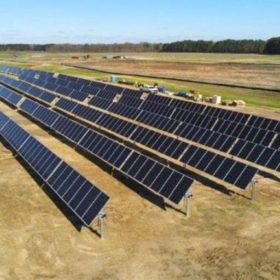The Oglethorpe Power Corporation that provides generation and transmission for Georgia’s rural electric distribution cooperatives could cost-effectively replace much of its fossil generation and meet projected demand growth through 2032 with 12 GW of solar and 4 GW of battery storage, with support from a $9.7 billion U.S. Department of Agriculture program, says a report from the nonprofit Sierra Club.
The Sierra Club found that the added solar and storage capacity for Oglethorpe’s system would reduce customer costs by nearly 25%, saving almost $640 million per year by 2030. The group relied on a modeling assessment conducted by researchers at University of California, Berkeley that used the National Renewable Energy Laboratory’s free ReEDS model.
Across Oglethorpe and four other rural generation and transmission cooperatives, the Sierra Club modeled cost-effective additions of 19 GW solar, 7 GW storage and 5 GW wind power. A total of 63 generation and transmission (G&T) cooperatives serve the nation’s rural electric distribution cooperatives.
The USDA is making $9.7 billion available to rural electric cooperatives under its New ERA program to deploy renewable energy systems, zero-emission and carbon capture systems. To apply, eligible entities must submit a letter of interest by September 15—a new, extended deadline.
“We fully expect” the USDA subsidy program “to be oversubscribed,” said Jeremy Fisher, senior strategy and technical advisor for the Sierra Club. Assuming that the USDA program is “maxed out” at $9.7 billion in 25% grants, Fisher said the program could support 24 GW of renewables and 10 GW of storage. But the Sierra Club found that just 11 G&T cooperatives could cost-effectively add 50 GW of renewables and 23 GW of storage with USDA grant support.
Many rural cooperatives might not pursue cost-optimal clean energy investments in the absence of the New ERA program, Fisher said. He added that the program makes battery storage for near-term capacity replacement “attractive” relative to maintaining coal or adding new gas for capacity purposes.
Yet even though modeling shows a large deployment of storage is cost-effective, Fisher said reaching that scale within the New ERA timeframe “may be logistically challenging.” He predicted less storage and more transmission investments than shown by the modeling used by the Sierra Club.
For two of the G&T cooperatives that it assessed, the Sierra Club relied on modeling using the EnCompass model from Anchor Power Solutions, conducted by Energy Futures Group. For another G&T cooperative, the Sierra Club relied on modeling using the free GenX model developed at Massachusetts Institute of Technology, conducted by an independent contractor.
The nonprofit group Union of Concerned Scientists has used the ReEDs model to validate 100% renewables by 2035 for 24 states whose governors support climate action.
The nonprofit group RMI has used the GenX model to develop a resource plan for two Kentucky utilities.
Rural electric cooperatives serve 42 million people, and operate in 92% of persistent poverty counties, says the National Rural Electric Cooperative Association on its website.
The Sierra Club describes itself as the nation’s largest grassroots environmental organization.
This content is protected by copyright and may not be reused. If you want to cooperate with us and would like to reuse some of our content, please contact: editors@pv-magazine.com.








By submitting this form you agree to pv magazine using your data for the purposes of publishing your comment.
Your personal data will only be disclosed or otherwise transmitted to third parties for the purposes of spam filtering or if this is necessary for technical maintenance of the website. Any other transfer to third parties will not take place unless this is justified on the basis of applicable data protection regulations or if pv magazine is legally obliged to do so.
You may revoke this consent at any time with effect for the future, in which case your personal data will be deleted immediately. Otherwise, your data will be deleted if pv magazine has processed your request or the purpose of data storage is fulfilled.
Further information on data privacy can be found in our Data Protection Policy.